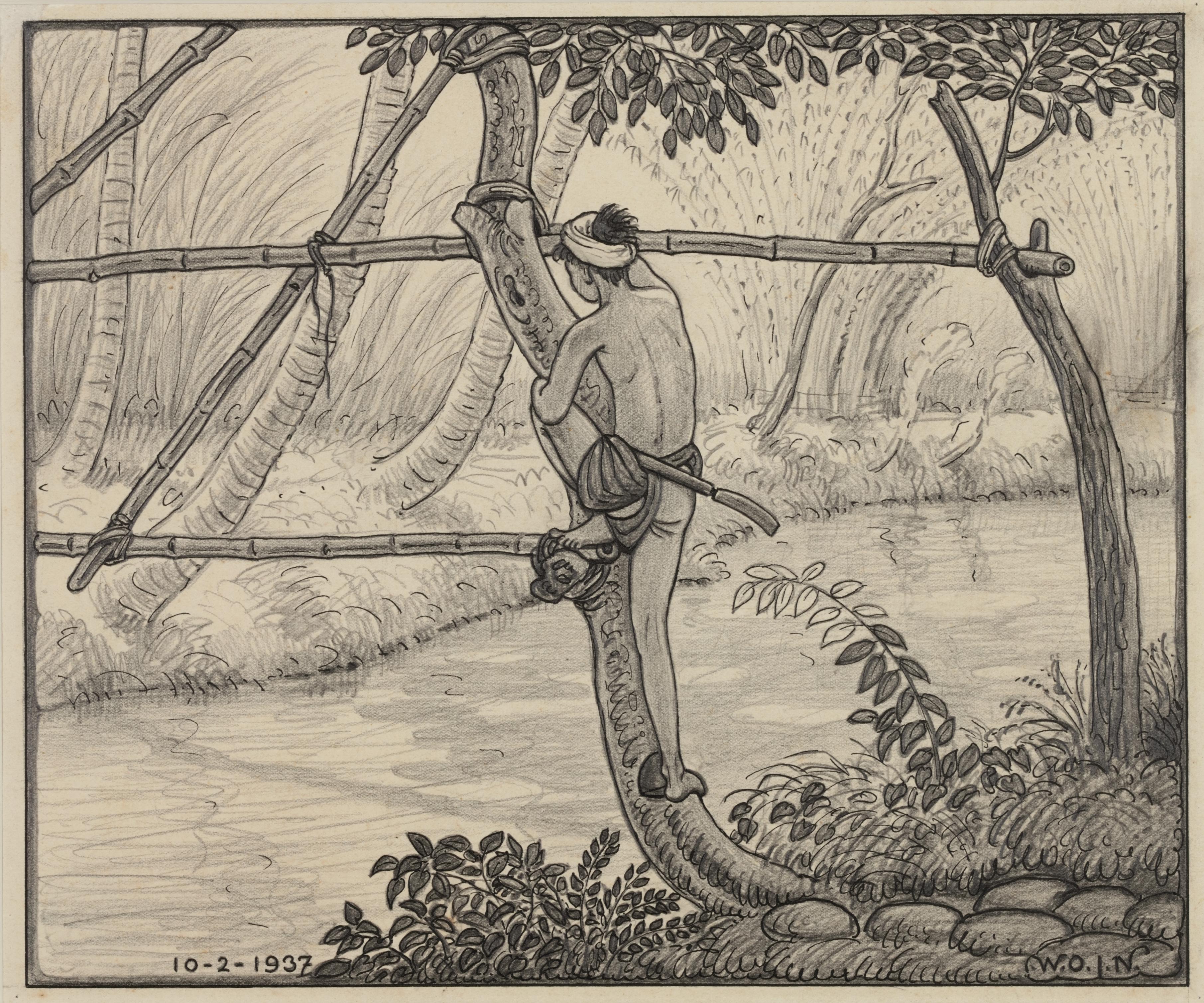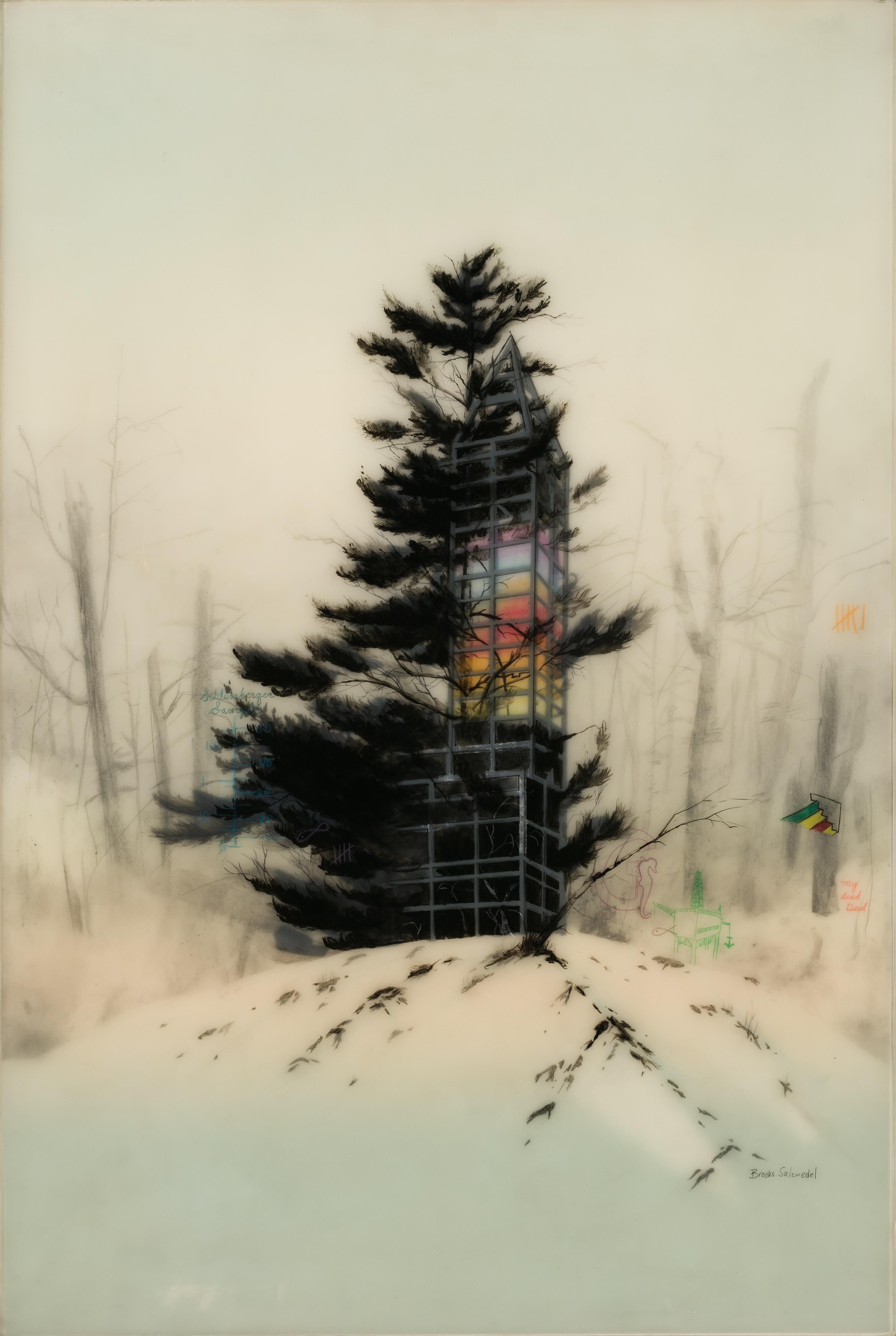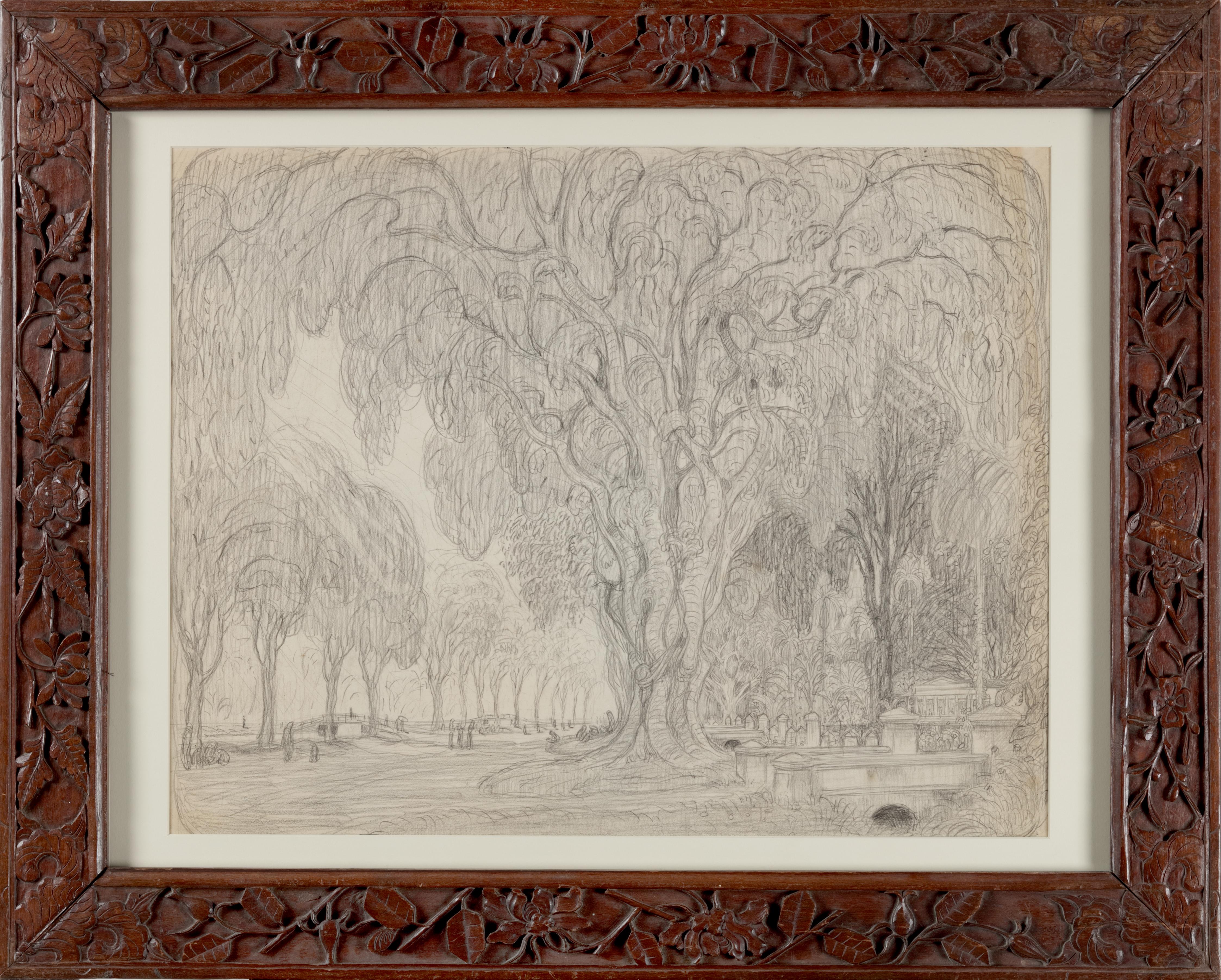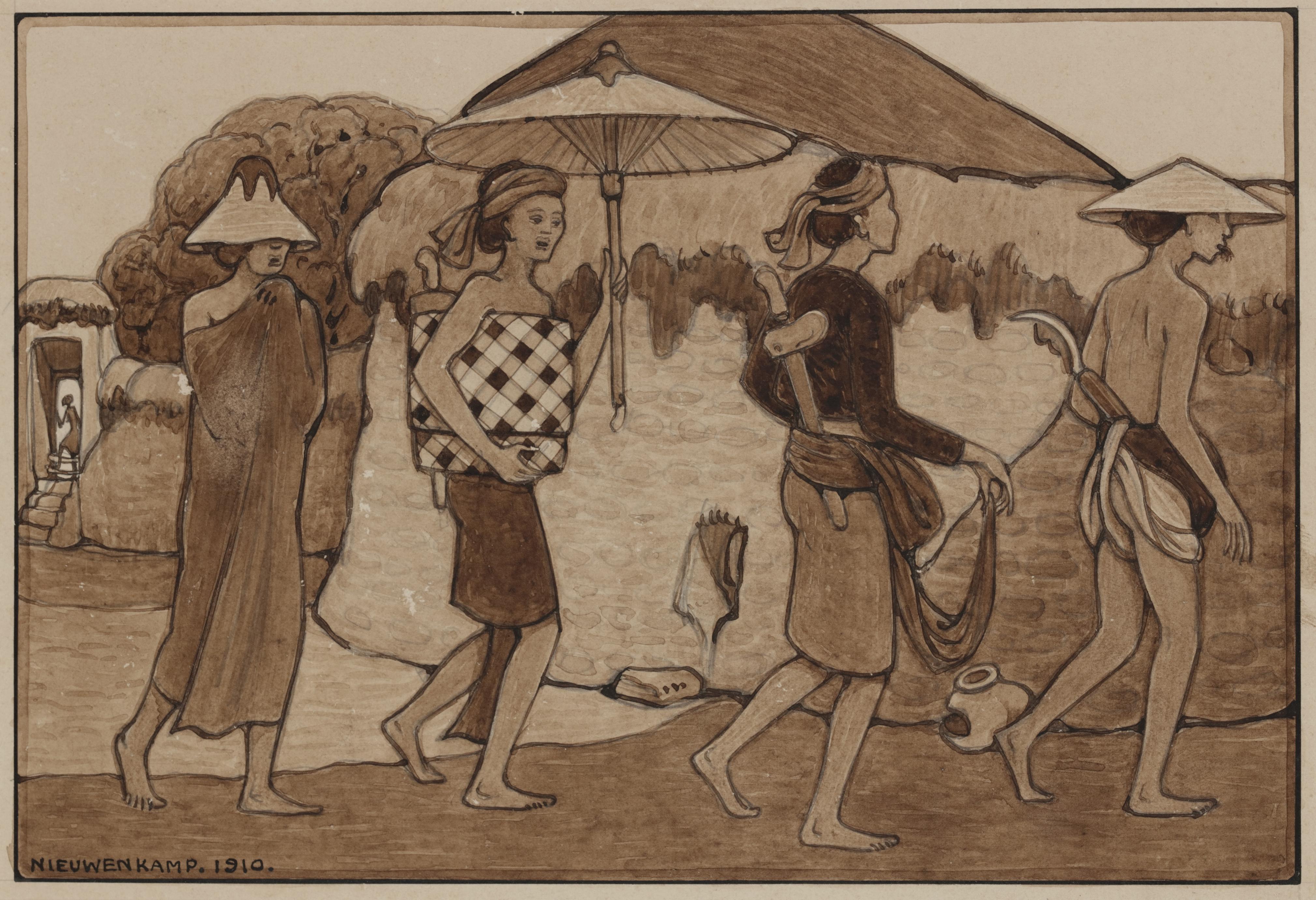Items Similar to Statue of Vishnu Garuda, Bali, 1904
Want more images or videos?
Request additional images or videos from the seller
1 of 2
W.O.J. NieuwenkampStatue of Vishnu Garuda, Bali, 1904 1904
1904
About the Item
Statue of Vishnu Garuda, Bali, 1904
Signed with initials
Pencil and ink on paper, 21.4 x 21.3 cm
Literature:
Bruce W. Carpenter, W.O.J. Nieuwenkamp. First European Artist in Bali, Abcoude 1997, p. 157
In ebonized frame with white mount
Willem Otto Wijnand Nieuwenkamp
(1874-1950)
Nieuwenkamp was born on July 27th 1874 in Amsterdam. His father owned sailing ships sailing to Indonesia and hearing the stories of the returning captains evoked in the young Nieuwenkamp an obsession for distant lands and adventure. After a failed attempt by his father to have his son make a career in his business, Nieuwenkamp attended the Academy for Decorative Art in Amsterdam. However, he left within one year to go his own way.
He was an autodidact and a great experimenter with new techniques, particularly in the art of etching. Nieuwenkamp was a very focused man with the discipline of a scientist tempered by the sensitivity of an artist, a lust for adventure, a natural appreciation for ethnic arts and an enormous ambition to tread new paths.
In 1898 he visited Indonesia for the first time and on his second visit in 1903-1904 he went on to Bali and became the first foreign artist to love Bali and the Balinese with a passion. Having secured agreements with several museums in the Netherlands to obtain Balinese art and objects for their collections, Nieuwenkamp immediately started to purchase and order a wide range of ethnographic art and objects from local artists and craftsmen.
Through his drawings and books, he gave an excellent impression of Balinese art and culture at that time. Since 1854 Northern Bali was under Dutch rule but Southern Bali in 1904, when Nieuwenkamp visited it, was still independent. Nieuwenkamp would be one of the last Westerners to experience a glorious medieval society in its final days. During his second visit to Bali in 1906 the Dutch decided to end the independence of South Bali and Nieuwenkamp was invited by the Governor-General van Heutz to accompany the Dutch invasion force. By contemporary European standards, the Balinese were barbarous and primitive, particularly with widows throwing themselves in the flames of the funeral pyre of their deceased husbands. But Nieuwenkamp was a singular man who saw in their society the beauty and soul that had been lost in his own.
On September 20th, 1906, Denpasar, the capital of South Bali fell to the Dutch military forces. Official military briefings praised the victory which was reported with nationalistic pride on the front pages of all Dutch newspapers. As Nieuwenkamp had witnessed, the truth was far from glorious. As if in trance the Balinese, men women and children, dressed in their finest silks and jewellery and armed with ancient bejewelled krises, the Raja himself mounted atop a golden palanquin, rushed forward, the men killing their wives and children and the Dutch machinegun fire doing the rest. The once-powerful and magnificent court of Denpasar was left in ashes and as many as two thousand Balinese dead. The Dutch suffered four deads.
Nieuwenkamp made drawings and saved as many beautiful architectural elements and artefacts from the rubbles as he could, most of it now in the collection of the Ethnological Museum in Leiden.
- Creator:W.O.J. Nieuwenkamp (1874 - 1950, Dutch, Indonesian)
- Creation Year:1904
- Dimensions:Height: 8.43 in (21.4 cm)Width: 8.39 in (21.3 cm)Depth: 0.04 in (1 mm)
- Medium:
- Movement & Style:
- Period:
- Framing:Frame IncludedFraming Options Available
- Condition:
- Gallery Location:Amsterdam, NL
- Reference Number:1stDibs: LU147128030282
About the Seller
No Reviews Yet
Vetted Seller
These experienced sellers undergo a comprehensive evaluation by our team of in-house experts.
1stDibs seller since 2021
Typical response time: 9 hours
- ShippingRetrieving quote...Ships From: Amsterdam, Netherlands
- Return PolicyA return for this item may be initiated within 7 days of delivery.
More From This SellerView All
- Wobbly bridge, Tabanan, Bali, 1937Located in Amsterdam, NLWobbly bridge, Tabanan, Bali, 1937 Signed with initials bottom right and dated, bottom left Pencil and ink on paper, 22 x 26.3 cm In ebonized frame with white mount Willem Otto Wi...Category
1930s Art Nouveau Landscape Drawings and Watercolors
MaterialsIndia Ink, Paper, Pencil
- Beach of Kusambe, Bali 1937Located in Amsterdam, NLFour outrigger proa’s on the beach of Kusambe, Bali, 1937 Signed with initials, dated and described with location bottom left Pencil and ink on paper, 29.7 x 35 cm In ebonized frame with white mount WILLEM OTTO WIJNAND NIEUWENKAMP (1874-1950) Nieuwenkamp was born on July 27th 1874 in Amsterdam. His father owned sailing ships sailing to Indonesia and hearing the stories of the returning captains evoked in the young Nieuwenkamp an obsession for distant lands and adventure. After a failed attempt by his father to have his son make a career in his business, Nieuwenkamp attended the Academy for Decorative Art in Amsterdam. However, he left within one year to go his own way. He was an autodidact and a great experimenter with new techniques, particularly in the art of etching. Nieuwenkamp was a very focused man with the discipline of a scientist tempered by the sensitivity of an artist, a lust for adventure, a natural appreciation for ethnic arts and an enormous ambition to tread new paths. In 1898 he visited Indonesia for the first time and on his second visit in 1903-1904 he went on to Bali and became the first foreign artist to love Bali and the Balinese with a passion. Having secured agreements with several museums in the Netherlands to obtain Balinese art and objects for their collections, Nieuwenkamp immediately started to purchase and order a wide range of ethnographic art and objects from local artists and craftsmen. Through his drawings and books, he gave an excellent impression of Balinese art and culture at that time. Since 1854 Northern Bali was under Dutch...Category
1930s Art Nouveau Landscape Drawings and Watercolors
MaterialsIndia Ink, Paper, Pencil
- Borobudur, Java, Indonesia (1937)Located in Amsterdam, NLGraveyard with in the background the Borobudur, 1937 Signed with initials and dated bottom left Pencil and ink on paper, 33 x 29 cm In ebonized frame with white mount Literature: ...Category
1930s Art Nouveau Landscape Drawings and Watercolors
MaterialsPaper, Ink, Graphite
- Weltevreden, Kebon Sirih, & Vlucht voor de bui (Fleeing the rain)Located in Amsterdam, NLWeltevreden, Kebon Sirih, & Vlucht voor de bui (Fleeing the rain) Executed between February 20 and March 2, 1918 Double sided drawing in graphite pencil on paper Images: c. 33 x 5...Category
1910s Art Nouveau Landscape Drawings and Watercolors
MaterialsGraphite, Paper
- Four Balinese, Bali (1910)Located in Amsterdam, NLFour Balinese, 1910 Signed and dated bottom left Pencil and ink on paper, 15.6 x 23 cm In ebonized frame with white mount. Literature: W.O.J. Nieuwenkamp, Zwerftochten op Bali, Amsterdam, 1910, p. 36 WILLEM OTTO WIJNAND NIEUWENKAMP (1874-1950) Nieuwenkamp was born on July 27th 1874 in Amsterdam. His father owned sailing ships sailing to Indonesia and hearing the stories of the returning captains evoked in the young Nieuwenkamp an obsession for distant lands and adventure. After a failed attempt by his father to have his son make a career in his business, Nieuwenkamp attended the Academy for Decorative Art in Amsterdam. However, he left within one year to go his own way. He was an autodidact and a great experimenter with new techniques, particularly in the art of etching. Nieuwenkamp was a very focused man with the discipline of a scientist tempered by the sensitivity of an artist, a lust for adventure, a natural appreciation for ethnic arts and an enormous ambition to tread new paths. In 1898 he visited Indonesia for the first time and on his second visit in 1903-1904 he went on to Bali and became the first foreign artist to love Bali and the Balinese with a passion. Having secured agreements with several museums in the Netherlands to obtain Balinese art...Category
1910s Art Nouveau Landscape Drawings and Watercolors
MaterialsPencil, Paper
- Market under the Banyan, Bali, 1937Located in Amsterdam, NLMarket under the Banyan tree, 1937 Signed with initials and dated bottom right Pencil and ink on paper, 28 cm x 34.5 cm Literature: Bruce W. Carpenter, W.O.J. Nieuwenkamp. First ...Category
1930s Art Nouveau Landscape Drawings and Watercolors
MaterialsGraphite, Paper
You May Also Like
- Absence/No PresenceBy Brooks SalzwedelLocated in Denver, COAbsence/No Presence, 2019Category
21st Century and Contemporary Landscape Drawings and Watercolors
MaterialsPanel, Resin, Mylar, India Ink, Color Pencil, Graphite
- "Medieval Thoughts, Prague, " Alphonse Mucha, Czech Art Nouveau IllustrationBy Alphonse MuchaLocated in New York, NYAlphonse Mucha (Czech, 1860 - 1939) Medieval Thoughts, circa 1890 Wash, ink, and watercolor on paper 11 x 9 inches Signed lower right Provenance: Phillips New York, 19th and 20th ce...Category
1890s Art Nouveau Figurative Drawings and Watercolors
MaterialsWatercolor, Ink, Paper
- Fairies among the Lily Pads - Female Illustrator FantasyLocated in Miami, FLA turn-of-the-century fantasy illustration by female illustrator May Audubon Post features a charming fairy with expanded wings resting on Lilly s...Category
Early 1900s Art Nouveau Figurative Drawings and Watercolors
MaterialsPaper, Ink, Watercolor
- Village - Original China Ink on Paper - 20th CenturyLocated in Roma, ITVillage is an original drawing in China ink on paper realized by an Anonymous artist of the XX century. The State of preservation is very good wit...Category
20th Century Contemporary Figurative Drawings and Watercolors
MaterialsIndia Ink, Paper
- Indian Figurative, Drawing, Ink on Paper, Two sided work by Indra Dugar"In Stock"By Indra DugarLocated in Kolkata, West BengalIndra Dugar - Untitled - 8 x 10.5 inches (unframed size) & 16 x 18.5 inches ( framed size ) This is a two sided works, Recto & Verso. Set of 5 art works. Ink on Paper. Inclusive of shipment in framed form. Style : Dugar was known for his paintings of rustic scenes en plein air, painted in a non-academic style, yet retaining colour harmony to reflect the tranquillity of his subject matter. He learnt how to structure his landscapes from Nirode Mazumdar and Rathin Moitra, and from his father, he inherited the tradition of painting on silk. Watercolour and tempera were his preferred media. Dugar's earlier works leaned heavily on his observations, but he gradually began paring down detail. Dugar soon outgrew the Bengal School...Category
1960s Modern Figurative Drawings and Watercolors
MaterialsPaper, Ballpoint Pen, India Ink, Ink
- Figurative, Drawings, Ink on Paper, Two sided work by Indra Dugar "In Stock"By Indra DugarLocated in Kolkata, West BengalIndra Dugar - Untitled - 8 x 10.5 inches (unframed size) & 16 x 18.5 inches ( framed size ) This is a two sided works, Recto & Verso. Set of 5 art works. Ink on Paper. Inclusive of shipment in framed form. Style : Dugar was known for his paintings of rustic scenes en plein air, painted in a non-academic style, yet retaining colour harmony to reflect the tranquillity of his subject matter. He learnt how to structure his landscapes from Nirode Mazumdar and Rathin Moitra, and from his father, he inherited the tradition of painting on silk. Watercolour and tempera were his preferred media. Dugar's earlier works leaned heavily on his observations, but he gradually began paring down detail. Dugar soon outgrew the Bengal School...Category
1960s Modern Figurative Drawings and Watercolors
MaterialsInk, Paper, India Ink, Ballpoint Pen





